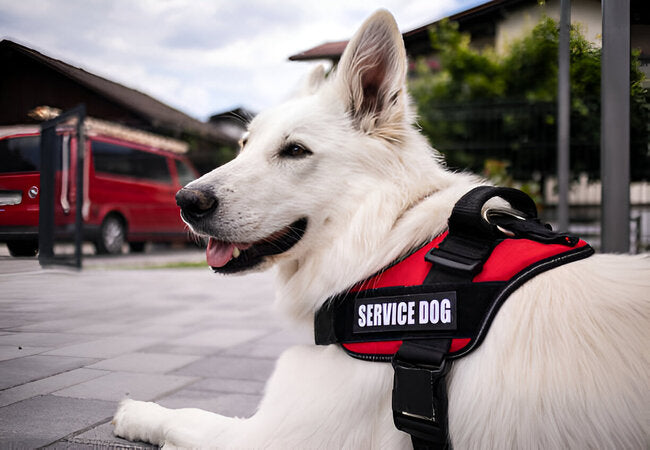Service Dog Types: 2025 Vet-Approved Training & Selection Guide 🦮✨

In this article
🐕🦺 Types of Service Dogs 2025: Roles, Training, Breeds & Choosing the Right Partner
By Dr. Duncan Houston BVSc
📘 What Is a Service Dog?
Under the ADA, a service dog is a dog specially trained to perform specific tasks directly related to a person’s disability—whether physical, sensory, psychiatric, intellectual, or neurological. Unlike therapy or emotional support animals, service dogs have legal access to public places and provide essential functional help—not just emotional comfort.
🛡️ Key Traits of an Effective Service Dog
Most successful service dogs share these qualities :
- 🎯 Desire to work—enthusiasm to be helpful
- 🧘 Calm demeanor—steady in public, unfazed by distractions
- 🧠 Intelligence—able to learn and choose wisely
- 🤗 Friendly disposition—comfortable among people and animals
- 💪 Physical ability—depends on the role (mobility dogs are bigger, scent dogs can be smaller)
Typical breeds include Labradors, Golden Retrievers, German Shepherds, Poodles, and occasionally Bernese Mountain Dogs, Border Collies, Boxers, Great Danes, and Pomeranians .
🐶 1. Guide Dogs (Seeing-Eye Dogs)
Guide dogs assist individuals with visual impairments by navigating obstacles, stopping at curbs/steps, and practicing “intelligent disobedience”—ignoring commands when safety requires it.
Common breeds: Labrador and Golden Retrievers, German Shepherds, Poodles for those with allergies .
👂 2. Hearing Dogs
These dogs alert deaf or hard-of-hearing individuals to sounds like doorbells, alarm clocks, smoke alarms, phones, and crying babies. They often respond with a nudge or lead the person to the sound’s source .
Popular breeds: Labradors, Golden Retrievers, Cocker Spaniels, Poodles .
⚕️ 3. Medical Alert & Seizure Response Dogs
Medical alert dogs detect physiological changes linked to diabetes (high or low sugars), epileptic seizures, or cardiac events—alerting before symptoms onset .
Seizure response dogs can fetch help, assist physically during seizures, and provide safety by positioning themselves around the handler .
🪑 4. Mobility Assistance Dogs
Mobility service dogs help with balance, retrieval of dropped items, opening doors, extinguishing lights, turning on switches, and even assisting wheelchair users .
Common breeds: Labradors, Goldens, German Shepherds—medium-to-large sizes needed for strength and stability .
👨🎓 5. Autism Service Dogs
Autism service dogs support autistic children and adults by enhancing social engagement, preventing elopement, interrupting harmful behaviors, and offering sensory grounding in overstimulating environments .
Breeds suited: calm, non-reactive dogs—often Labradors or Goldens in small sizes.
🧠 6. Psychiatric Service Dogs (PSDs)
PSDs assist individuals with PTSD, severe anxiety, depression, bipolar disorder, or other psychiatric conditions. Their tasks include interrupting panic attacks, reminding medication, applying deep pressure, or providing a buffer in crowds .
🌾 7. Allergy Detection Dogs
Allergy detection dogs identify specific allergens like peanuts, gluten, or eggs through scent detection before exposure occurs—vital for individuals at risk of anaphylaxis .
Typically small-to-medium breeds with strong olfactory skills.
🏢 8. Facility & Public Access Service Dogs
These dogs assist professionals in settings such as schools, hospitals, courthouses, and therapy centers. Their tasks include opening doors, retrieving items, calming participants during stress or testimonies
Also known as facility dogs.
🐕🧒 9. Pediatric Companion & Program Dogs
These are support dogs placed with children to increase social interactions, learning, and independence. They often serve as precursors to guide or service dogs by conditioning children to safe handling .
🐾 Comparing the Roles
| Service Type | Main Tasks | Typical Breed Traits |
|---|---|---|
| Guide | Navigate hazards, intelligent disobedience | Calm, medium-large retrievers/shepherds |
| Hearing | Alert to sounds, lead to the source | Alert, sociable breeds |
| Medical/Seizure | Scent detect, fetch, provide safety | Scent-sensitive, focused dogs |
| Mobility | Retrieve items, brace, open doors | Strong, steady, size matters |
| Autism | Sensory grounding, protect & interrupt | Calm, confident, attentive dogs |
| Psychiatric | Panic interrupt, med reminders, deep pressure | Affectionate, aware of handler |
| Allergy | Detect allergens in environment/food | Scent driven, disciplined |
💡 Training & Timeframe
Service dog training usually takes 1–2 years and involves:
- 🔹 Basic obedience & public school
- 🔹 Task-specific work (e.g., scent detection, mobility support)
- 🔹 Socialization in diverse settings
- 🔹 Handler adjustment & bond-building
Under the ADA, no certification or vest is legally required—but reputable programs often provide training and identification for practical reasons .
🧾 Choosing the Right Service Dog for You
- Identify tasks needed: mobility support, alert functions, sensory support.
- Choose breed traits appropriate to tasks: size, demeanor, scent acuity.
- Partner with accredited training programs or utilization of owner-guided training (ADA allows) .
- Prepare for lifestyle changes: daily care, public access, ongoing training.
🧸 How Ask A Vet, Woopf & Purrz Support You
- 🩺 **Ask A Vet**: Guidance on breed-health screening, task suitability, and managing service dog health needs.
- 🎾 **Woopf**: Essential equipment—training vests, mobility harnesses, scent detection rewards, public access gear.
- 🍃 **Purrz**: Supplements to support coat, joints, digestion—especially helpful in service dog's daily routines.
🎯 Final Thoughts
Service dogs fill extraordinary roles—from guiding, alerting, supporting mobility, to offering emotional grounding. Understanding their specializations, training demands, and breed traits empowers individuals to choose the right companion dog. Whether professionally trained or owner-led, the process can be deeply rewarding.
— Dr Duncan Houston, BVSc
Considering a service dog? Visit AskAVet.com and download the Ask A Vet app for tailored advice on choosing, training, and caring for your future partner.






